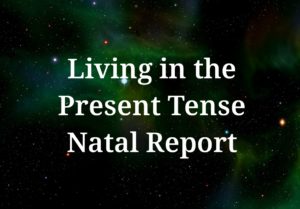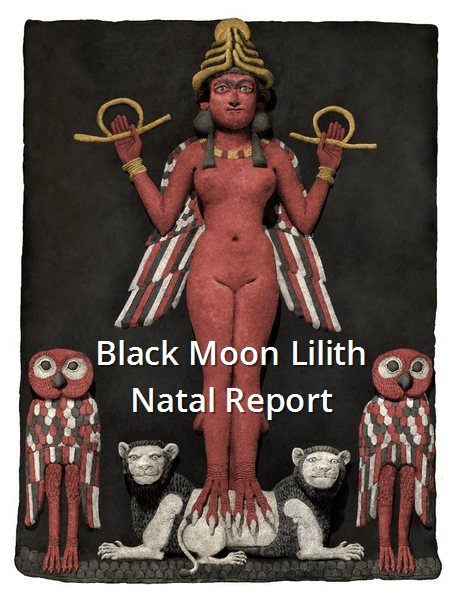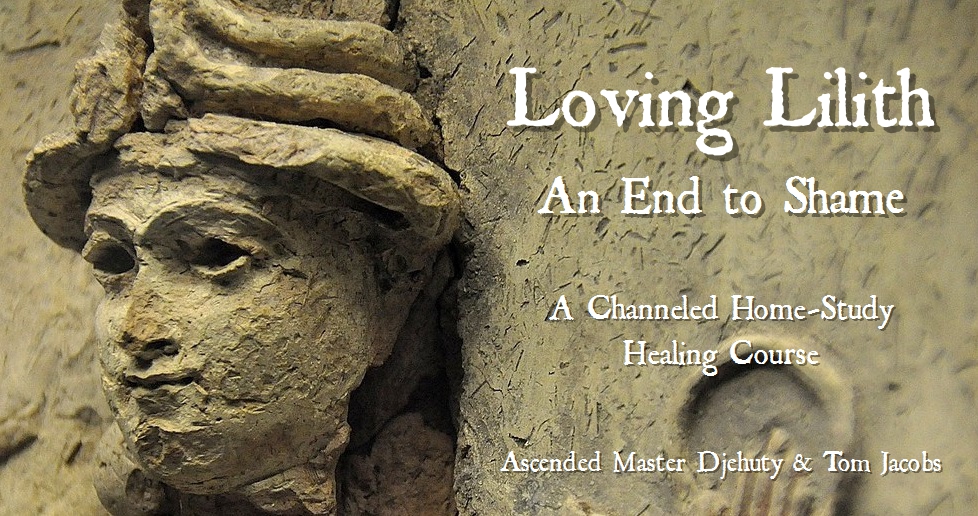New: Loving Lilith: An End to Shame Healing Course.
Get your own True Black Moon Lilith Natal Report.
Seeing in the Dark: Rethinking Lilith and Lucifer
© 2008 Tom Jacobs
Originally Published by the Astrological Society of South Africa
My work as a counseling astrologer and psychic medium has brought me to explore some of the darker sides of human experience. (I have to feed my Scorpio Sun somehow!) Whether working with a client on healing issues of abuse or working with a spirit on healing whatever reasons he or she is still hanging around the Earth plane, I’ve found that acknowledging the darker parts of life is necessary to support healing journeys, which are, after all, those to greater wholeness.
We all contain the dark as well as the light. What we might not realize is that we have a choice about how we use our energies, what we engender in the world, what we energize and take with us where we go. We tend to fear our darker possibilities, but being whole requires acknowledging all parts of ourselves.
Over the last few years I’ve worked extensively with two archetypes thought to be about darkness, and therefore to be avoided. Lilith and Lucifer represent aspects of ourselves that have been intentionally and systematically demonized by those creating and shaping cultures in many parts of the world. I’d like to share with you an overview of what I’ve learned from working closely with these archetypes with myself, colleagues and clients for a few years, including why we’ve been taught to fear them, what they represent, how we can learn to make peace with these parts of ourselves, as well as what is to be gained from doing so.
 My Living in the Present Tense Natal Report helps you understand and heal Lilith, Lucifer, Pluto, and Chiron in your own chart.
My Living in the Present Tense Natal Report helps you understand and heal Lilith, Lucifer, Pluto, and Chiron in your own chart.
These two archetypes are central to the teachings of Judeo-Christian cultures. An important goal of any society is to teach its people how to be good and productive members of the social order. Given this, how surprising is it to hear that archetypes that represent trusting one’s instinct and trusting one’s voice of doubt would be said to be evil? Yet as we emerge from the Piscean Age with its directive to receive information and instructions from above, the Aquarian Age challenges each individual to seek answers inside him- or herself. At this change of Ages, we’re being asked to evolve into more self-sufficient, self-reliant and whole beings. As much as we can let go of our assumptions about ourselves and simply know ourselves directly, the more prepared we are to take care of ourselves and take back our personal power – the better off we are.
Lilith (The True Black Moon and Asteroid 1181)
I see Lilith as representative of a person’s connection to the primal wild, telling of his or her instinctive nature. What she offers centers on the wisdom of the body as an extension of the natural world, and our willingness to trust our own instincts in large part determines our experience of this archetype. Being a good member of society (as society has developed over the last few thousand years) requires that we learn to fear and limit the incursion of the wild into our highly structured and ordered lives, and so when individuals bring Lilith’s energy out, we’re supposed to fear them and do what we can to limit their expression. This manifests as all manner of control, power and abuse games when individuals bring too much instinctual energy or insistence of paying attention to the Earth and its other inhabitants, and sticking with or returning to more natural ways of living. Lilith is demonized in Judeo-
Christian cultures so that we learn to deny and feel shameful about the parts of us that can’t be controlled, as control is the name of the game in cultures such as ours.
I’ve found the true Black Moon to symbolize a person’s personal experiences and feelings surrounding suppression of creativity and sexuality, and inequality. The asteroid Lilith, on the other hand, I see as telling of a less-personal awareness of larger, related trends. The asteroid Lilith I have not found to have as personal a place in people as the true Black Moon. When the true Black Moon is prominent, there’s a personal experience of embracing or denying the wild, of identifying the self as an extension of nature or refusing to do so. In contrast, when the asteroid Lilith is prominent, people are invested in or working against social causes or the plight of those experiencing suppression or inequality around him or her, or somewhere/anywhere in the world.
 The single most important factor influencing how an individual experiences the Lilith archetype is conditioning. What was that person taught about the influence of nature? Was passionate conviction represented in the family growing up or not? Did men and women in the family treat each other as equals, or was there a second class? Was sexuality seen as a vital and healthy part of a person’s being, or was it feared, demonized and shamed? Was menstruation seen as a natural process or something a woman should feel shame about? How about the family’s reaction to persistent insects in or around the home, uncontrollable weather, or human rights issues? If he or she was raised in a religious tradition, did that tradition honor or fear the natural world? Was he or she taught that humans are the highest of all life forms, or that they’re a part of nature?
The single most important factor influencing how an individual experiences the Lilith archetype is conditioning. What was that person taught about the influence of nature? Was passionate conviction represented in the family growing up or not? Did men and women in the family treat each other as equals, or was there a second class? Was sexuality seen as a vital and healthy part of a person’s being, or was it feared, demonized and shamed? Was menstruation seen as a natural process or something a woman should feel shame about? How about the family’s reaction to persistent insects in or around the home, uncontrollable weather, or human rights issues? If he or she was raised in a religious tradition, did that tradition honor or fear the natural world? Was he or she taught that humans are the highest of all life forms, or that they’re a part of nature?
As an example, it can be difficult for those of us taught to fear nature to accept, let alone make peace with and embrace, the natural functions and processes of our bodies. The allopathic medical model informs most of those raised in Western cultures and views disease and illness as malfunctions of the body, not as valid sources of information about what’s happening with and within a person’s entire being. The more we view our bodies as machines with all sorts of things going wrong all the time, the less inclined we’ll be to develop a healthy relationship with the energy of Lilith. Lilith asks that we open to feeling our bodies as extensions of nature. And when we do this, the allopathic medical model of destruction no longer appeals to us. With Lilith’s voice in us heard, we choose holistic and nature-based remedies to imbalances in our whole being as manifested in our bodies. When we are willing to hear Lilith, we move into a more loving and accepting approach to being in and caring for our bodies.
Health and wellness is just one angle on how to understand one’s relationship with Lilith. Others include what we eat and how we choose it, the kinds of fabrics we wear and cleaning products we use, and how we view sex and sexuality. In all of these areas and more, learning to recognize and accept ourselves as extensions of nature leads us to a greater sense of wholeness, of allowing the wisdom of our bodies and instinctual natures to inform our choices and expressions, and therefore identities.
Astrologically, a person’s Lilith signs (true Black Moon and asteroid) tell of the style of their Lilith expression as well as the ways of being that might be edited to avoid being suppressed or abused for expressing wildness. The houses tell of where in life Lilith issues will play out. Aspects to natal planets and points show us what energies in the psyche Lilith is involved in conversation with, what inner voices provide or deny support for developing and expressing one’s relationship with his or her instinctive wild.
Lucifer (Asteroid 1930)
I work with Lucifer as representing the voice of doubt, and the choice we each make to serve something greater than ourselves or to work against it. We each have what I call an “inner goodness barometer.” While what we think of as good varies (there is no single right definition of “good”), we each have a feeling inside us about what it is for us. Do we align ourselves with it and work to support it, or do we avoid doing so, whether in denying support or working against it?
In Judeo-Christian cultures, the voice of doubt is demonized so that individuals learn not to question the instructions of those higher in the social food chain. Remember that the Piscean Age asks us to do what we’re told and ask no questions. There is a power an individual has when he or she doubts the prevailing agenda and instructions and relies on inner knowledge for guidance. From the standpoint of these cultures, individuals must not be allowed to doubt their instructions and learn to live according to their own consciences. Those that shape th e culture believe that society would fall apart if this were to happen, and yet at the beginning of the Aquarian Age, the shapes of our cultures have no choice but to change in the direction of increased self-knowledge, self-acceptance, and self-love; of listening to ourselves over those perceived to be higher in the social food chain.
e culture believe that society would fall apart if this were to happen, and yet at the beginning of the Aquarian Age, the shapes of our cultures have no choice but to change in the direction of increased self-knowledge, self-acceptance, and self-love; of listening to ourselves over those perceived to be higher in the social food chain.
The voice of doubt in each of us says that if we bring out what is symbolized by our Lucifer placement, we’ll be egotistical. One of the biggest no-nos of life in societies informed by Judeo-Christian ethics is to be arrogant, to put the self first. Selfishness is not encouraged, and yet what we might call enlightened self-interest can be assumed to be selfishness in this mindset, and therefore be avoided. As it happens, though, Lucifer represents our greatest gifts, what we can develop and offer as our most heart-felt service to others. Giving this service makes us feel aligned with what we feel is good, which is to say whatever we might call God/Goddess/Creator/Creatrix.
When we can learn the difference between enlightened self-interest and selfishness and commit to developing and bringing out our greatest gifts, we come to feel aligned with what we know is good. In the Hebrew version of Lucifer’s mythology, where this archangel is called Samael, his devotion to serving what he knows is good is made clear. The reason for his departure from God’s presence is not about an inflated ego (as we’re told) but a perception that God is transgressing God’s own logic by asking the angels to bow down before Adam, a being made of dust. God asserts that Adam is the greatest thing ever next to God, and Samael feels he has to leave in order that his service remain rooted in integrity, as the angels have been told that they reflect God’s own divine essence. He never stops wanting to serve God (what he knows is good), he simply has to withdraw his support in a time when he perceives God is out of integrity. When the story is translated into serving the needs of Christianity and his name is changed to Lucifer, the figure is made into a caricature of arrogance and petty self-interest, leaving people wanting to be good little members of society thinking that Lucifer’s problem is that his ego is too big and that they need to avoid that at all costs lest they be labeled evil.
Lucifer in the natal chart tells us the part of us we’re inclined to doubt that we should develop. It’s a part of us we’ll avoid really giving attention for fear of being or being perceived to be selfish, arrogant, self-aggrandizing. Yet it is the road to developing and giving our greatest gifts. The road through this begins with learning to consult our hearts to learn about our true motivations. It is true that Lucifer energy can lead us to arrogance if taken too far, and the secret to not taking it too far is to get in touch with why we’re doing what we’re doing. If our motivations are in line with us as whole beings (which is something the heart is very good at telling us), then Lucifer’s input can be put into service of what we as wholes want to accomplish. If we do not consult the heart and go with what our heads are telling us, then we can certainly go off track and end up overdoing the right size or place of ego and mind in our lives.
The Lucifer sign in a chart tells us about the way of being that the native will hesitate to develop for fear of being or being perceived to be arrogant, yet also the way of being that leads us to give our greatest gifts. The Lucifer house indicates the arena of life in which the voice of doubt will play itself out, what part of life we may avoid strengthening though it is the site of our greatest gifts. Aspects Lucifer makes to other planets and points in the chart represent what parts of the person Lucifer is informed by and informing, what type of cues the voice of doubt is taking from whom and what parts of the person are needed to support developing and giving the greatest gifts he or she can offer.
Conclusion
Rethinking the nature and potential uses of shadow archetypes is critical as we transition from the Piscean Age to the Aquarian Age. True self-knowledge requires that we grab our flashlights and understand just what it is that’s lurking in our darkest corners. The times we live in invite us to make peace with our true natures and learn to untangle what we’ve been told about who we are. The Lilith and Lucifer archetypes are excellent places to begin this process of integration and deepening self-acceptance and self-love.
